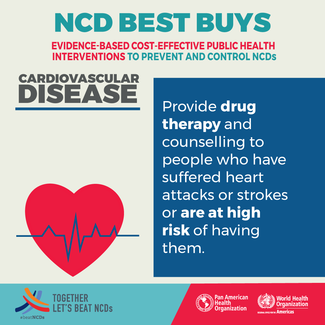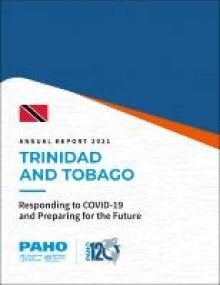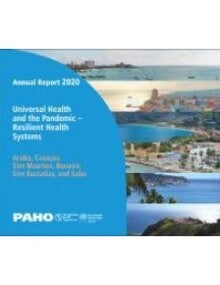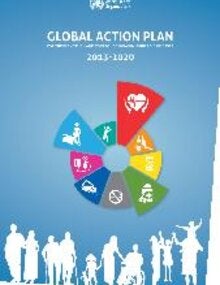Chronic noncommunicable diseases (NCDs) are the number one cause of death and disability in the world.
The term NCDs refers to a group of conditions that are not mainly caused by an acute infection, result in long-term health consequences and often create a need for long-term treatment and care. These conditions include cancers, cardiovascular disease, diabetes and chronic lung illnesses.
Many NCDs can be prevented by reducing common risk factors such as tobacco use, harmful alcohol use, physical inactivity and eating unhealthy diets. Many other important conditions are also considered NCDs, including injuries and mental health disorders.
- Noncommunicable diseases (NCDs) kill 41 million people each year worldwide, equivalent to 71% of all deaths globally. In the Region of the Americas, 5.5 million deaths are by NCDs.
- Each year, 15 million people -2.2 million in the Region of the Americas - die from a NCD between the ages of 30 and 69 years; over 85% of these "premature" deaths occur in low- and middle-income countries.
- Cardiovascular diseases account for most NCD deaths, or 17.9 million people annually, followed by cancers (9.0 million), respiratory diseases (3.9million), and diabetes (1.6 million), globally.
- These 4 groups of diseases account for over 80% of all premature NCD deaths.
- Tobacco use, physical inactivity, the harmful use of alcohol and unhealthy diets all increase the risk of dying from a NCD.
- Detection, screening and treatment of NCDs, as well as palliative care, are key components of the response to NCDs.
Modifiable behavioral risk factors
Modifiable behaviors, such as tobacco use, physical inactivity, unhealthy diet, and the harmful use of alcohol, all increase the risk of NCDs.
- Tobacco accounts for over 7.2 million deaths every year (including from the effects of exposure to second-hand smoke) and is projected to increase markedly over the coming years. (1)
- 4.1 million annual deaths have been attributed to excess salt/sodium intake. (1)
- More than half of the 3.3 million annual deaths attributable to alcohol use are from NCDs, including cancer. (2)
- 1.6 million deaths annually can be attributed to insufficient physical activity. (1)
Metabolic risk factors
Metabolic risk factors contribute to four key metabolic changes that increase the risk of NCDs:
- raised blood pressure
- overweight/obesity
- hyperglycemia (high blood glucose levels) and
- hyperlipidemia (high levels of fat in the blood).
In terms of attributable deaths, the leading metabolic risk factor globally is elevated blood pressure (to which 19% of global deaths are attributed), followed by overweight and obesity, and raised blood glucose.
The Pan American Health Organization promotes, coordinates, and implements technical cooperation activities directed to the prevention and control of non-communicable diseases (NCDs), related risk factors, disabilities, and mental, neurological and substance abuse disorders that are sound and appropriate for the culture and society.
PAHO raises political and public awareness and understanding of the burden of the most common NCDs, related risk factors, mental or neurological conditions, and leads multi-sector and multi-stakeholder strategic and collaborative efforts aimed at strengthening Member States' capacity to promote and protect health through public policies, programs, and services. This will reduce risks and disease burden in order to improve the physical, mental, and social well being of the population.



























